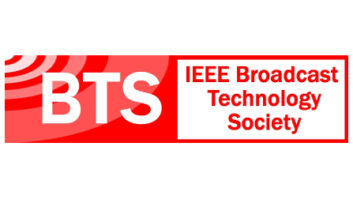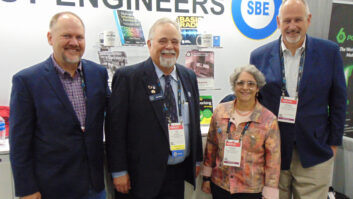Applied Technology: Programmable Logic Controllers for Broadcast Engineers
Sep 1, 2014 3:53 PM, Dennis Sloatman
As engineers, we often need to design a customized control system or interface to address a need which can”t be met with an off-the-shelf interface device. In the �used-to-be� days, we”d get a Bud box, some Greenlee punches, a box o” wire, parts to construct a 24-volt DC power supply, a handful of 24-volt 4PDT relays, grab a cup of coffee, and head for the shop. I, like many of you, derived a great deal of satisfaction �back in the day� making these wonderful devices which performed their task tirelessly for decades.
Times have changed. Today, manufacturers have developed a line of really cool interface devices which can be combined to satisfy most of your control system needs. In some circumstances, however, you may still need to construct a discreet device control system (using a variety of timing devices, relays, diodes, counters, comparators, and analog circuitry), which requires a bit more �horsepower� and flexibility than off-the-shelf components can provide. In this case, you can choose the tried and true methods of using relays, sockets, capacitors, diodes, point-point wiring, and breadboard circuits, coupled with hours of assembly. This approach isn”t wrong by any means and will get you the results you want. In this article, however, I suggest an alternative: the PLC, or �Programmable Logic Controller.�
Definition of a PLC
Example PLCs
What is a PLC? Essentially, a PLC is a dedicated control block with multiple inputs and outputs (called �points� in PLC language) which are either digital or analog. These points are controlled by an internal CPU with flash-type memory for program retention. Most PLCs are din-rail mounted, which is in itself, a wonderful thing (see �Getting Started.�)
Depending on your need, you can select a PLC with a number of points ranging from as few as 10 to as many as thousands � with combinations of point types as required for your application. The PLC can be then be programmed to perform actions such as counters, latching relays, time-delay blocks of various types, comparators, RTC (Real Time Clock) functions, logic functions (and, or, inverter), math functions, and for/next loops. Other features are also available, and the capabilities will vary by the device selected. I”ll discuss some of these features in this article.
The good news is, you can have all of this capability for as little as $69. For a typical application, however, you can expect to spend approximately $150, not including the required power supply, din rail, and mounting panel.
Applications for the PLC
PLC devices are typically used for something other than the very limited market of broadcast tinkerers. Factories use PLCs for process control of machinery such as lathes, assembly line control, and for bottling and packaging operations. Utility companies use them to control and monitor water tank levels, fluid rate, as well as the temperature, flow and pressure of gases. PLCs are used to control vending machines, games, and any other industrial process which requires responses to input stimuli. These stimuli include limit switches, temperature, voltage/current levels, angular velocity� or a command to change to night pattern! Not only can a PLC provide a more robust, reliable and adaptable solution to your application than a PC-based system, but these devices are tough � they”re designed to work in an electrically noisy and harsh environment, such as a factory floor or a remote utility pumping station. It”s safe to say that PLCs are one of the most versatile devices available to any engineer.
Now let”s focus on applications for our industry. As I mentioned, I constructed a PLC-based antenna controller for one of our Los Angeles AM directional stations using a Teco model SG2-20HR-D (Figure 2).
PLC based AM antenna array controller
The key components of this assembly are (from left to right): PLC base unit, expansion unit, 2PDT 24-volt relays, and dual (redundant) 24-volt din-rail mounted power supplies. After constructing the controller, I realized that I could have reduced the labor of interconnection wiring, lowered the cost, and enhanced reliability simply by adding an additional expansion unit to eliminate the discrete relays.
When you consider the requirements for an AM directional antenna controller, you think of muting the RF of the transmitters with a small delay to allow the RF energy to dissipate prior to commanding the RF contactors to move. This will reduce or eliminate arcing and possible damage to the RF contactors, as well as avoiding a VSWR Trip (or equivalent fault) on your transmitter. The amount of time required can vary depending upon the type of transmitter. My informal survey of manufacturers has determined that the maximum delay required from initiation of the RF Mute command to the point at which no RF energy is present at the antenna terminals is approximately 200ms or less. So, there should be a delay of 200ms from the point at which a mode change is requested to the point at which the RF contactors are commanded to move to their alternate positions. Further, you would like a lockout on your antenna controller in the event that a command is issued which would not result in a mode change (that is, if you”re already in Day Mode and you press the �Day� button, no action would be taken � no undesired RF mute).
After the RF Mute has timed for 200ms, the next step is to issue the command to switch to the desired mode and to allow sufficient time for the contactors to move to the new position. So, when programming our PLC, we consider the time interval often referred to in data sheets as the �actuation time� or �operate time,� and is typically 100ms or less for RF contactors. Thus far, we have 200ms RF mute and 100ms RF contactor actuation time to consider as we work through our design. Another consideration is a �J factor,� which is the settling time of the RF contactors. Our antenna system must allow for all contactors in the system to switch to the new position. The controller must be programmed to issue a command of sufficient length to ensure that the slowest contactors have moved to their new positions. Of course, the switch positions can be monitored by the contactor auxiliary micro switches to be certain that all have contactors have switched (although not all systems have that luxury). After we”re sure all contactors have switched, we can un-mute the RF signal from the transmitter.
Listing all the details of this operation may seem trivial until you consider the work that is required to build a system to control it. The standard design utilizes conventional relays and either timing relays or relays with capacitors, resistors and diodes. The real issue is the time and labor involved to build the controller: laying out the components, cutting to length and stripping all of the interconnecting wires, tinning them, drilling all the mounting holes, and arranging wire management. The good news is, this same antenna operation can be controlled by a system design using a single PLC and, perhaps, some expansion units. The PLC not only cuts expense and construction time, but it provides a system whose operational functions can be modified easily by re-programming the PLC.
Getting Started
Before you begin constructing your PLC-based controller, consider setting up a test bed � particularly if you plan on doing more than one project. The test bed can be as simple or elaborate as you wish. Although it is not a requirement, a test bed can make PLC development and prototyping easier and allow you to setup simulations of your actual application. Figure 3 shows the test arrangement I use which has been added to and modified several times.
PLC Test Bed
Here you can see the din-rail mounted components including relays, power supplies, breakout panels, and relay assemblies. With this setup, I can simulate input closures (i.e. switches) and output loads with relays, LED”s, and small motors. For those of you not familiar with din-rail, it is a standard method of mounting components in the industrial world. Din-rail is inexpensive and can be cut to any size. It saves a considerable amount of time and effort when mounting components versus drilling numerous holes to secure discrete components.
Programming a PLC
The most common programming language of PLCs is �Ladder Logic� or �Ladder Diagram.� Let”s start. Programming a PLC requires the following steps:
- � Load the PLC-specific programming software into a PC.
- � Connect a serial cable or network cable to the PLC.
- � Write the ladder program in the PC.
- � Copy the ladder program to the PLC.
Ladder logic may seem complex, but once you get the �hang� of ladder diagrams, you”ll be able to write a working Ladder Logic program in a small fraction of the time that it would take to write a comparable program in a structured language.
Next, let”s discuss some common terms used when programming PLCs. Since these devices are designed to replace relays and contacts, you”ll be placing objects on the programming diagram called �coils� and �contacts.� Interestingly, a �coil� can be just that � an output relay coil in the PLC. It can also be used to represent a timer function, a comparator, an HMI (Human-Machine Interface display), a counter, and other functions as well. A �contact� can be an input to the PLC or it can be any one of a number of internal �closures� (the word �closure� is used somewhat loosely here � actually, an internal gate action) which can be used to trigger other coils.
In brief, coils are outputs of either internal or external objects; contacts are inputs which can be either an external trigger, or an internal closure (really a logical switch). This switch may, in turn, be used to activate other outputs.
Other Broadcast Applications
In this article I”ve discussed using a PLC for a directional antenna system controller. There are, however, many more potential broadcasting applications, including: Automatic STL switcher, FM Antenna Switch Controller, Automatic Power Control, Automatic Pressurization Controller (for transmission lines) and a Fault Detection and Response system.
Conclusion
I hope you”ve found this introduction to PLCs to be interesting and useful. There”s no doubt many of you have already used the PLC in some application and, if so, drop me an email � I”d love to hear about it! I have only scratched the surface and if you”d like to know more, just do a search on the keyword �PLC� on the internet and you”ll see lots of links for more information � including instructional videos and FAQ pages. If you need to design a custom controller for a specific need and want maximum reliability and functionality per dollar spent, these devices can”t be beat.
Dennis Sloatman is the director of engineering for Clear Channel, Los Angeles











